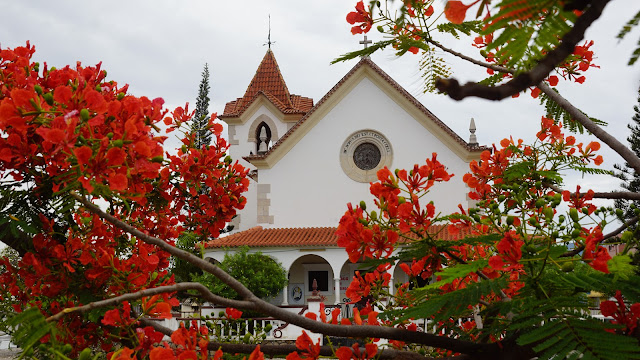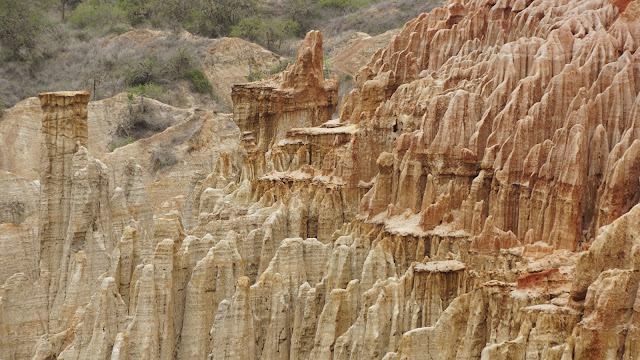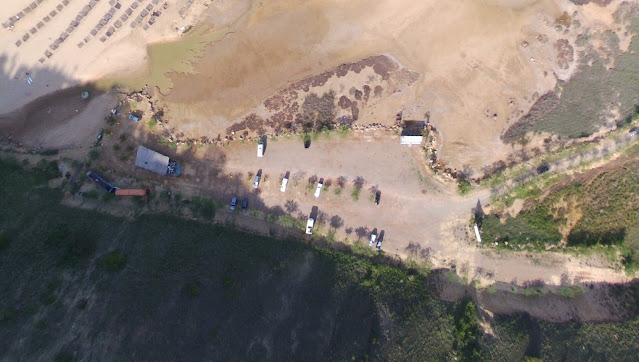2019-11-29: Lobito, The Restinga.
Friday, November 28
After two or three days in the mountains around Morro do Moco we are back on the Atlantic coast. We are approaching Lobito still about thirty kilometers away. The landscape has completely changed, we pass throug an arid and dusty region. The arrival on Lobite is hardly appealing, and even rather repulsive.
 |
| There is nothing attractive about the suburbs of Lobito, far from it! |

We descend to the port to reach the center of Lobito. Our goal is the Restinga de Lobito. The Restingas are those sandy peninsulas that stretch parallel to the Angolan coast. The two best known are those of Luanda (Ilha) and that of Lobito. This is the same geological phenomenon as for the Dakhla and Nouadhibou lagoons in the northern hemisphere. In the north it is the cold sea current of the Canaries which descends towards the south which is at the origin of these geographical formations, here it is about the equally cold current of Benguela which goes up towards the north.
 |
| The Restinga of Lobito. |
The city changes its face and becomes much more attractive… and richer. We go up the whole peninsula to the north along a large and wide boulevard lined with beautiful buildings and a multitude of restaurants. We stop at the end of the sand spit in a roadside parking lot, as recommended by David and Francine. They spent a night there without being disturbed.
We get there a little before 5:00 p.m. An Angolan is very surprised to see a German registration plate here. He is an expat who lives in Obersdorf in Bavaria, having also lived in Biberach (his Swabian accent betrayed him!). He is spending his vacation here and is soon coming back "home".
Christine sets off to reconnoitre the surroundings. The nearby bar is under construction, another is out of service, and a restaurant a little further down is preparing for a big reception tomorrow (maybe a wedding). We have the impression that this area at the end of the peninsula has just been serviced and that tourist establishments are just beginning to take possession of it.
We parked perpendicular to the waterfront and the little sea air struggled to find its way to our windows. It's hot in the cabin and we're running out of air.
The parking lot is relatively quiet. There are quite a few people but nothing unbearable.
Saturday, November 29
There is no reason to hurry to get up this morning because it has been raining continuously since the middle of the night, a fine Breton rain! And the sky is uniformly gray and low. The day at the beach seems compromised, but the weather can still change. Let’s wait for the tide and the effect of the sun.
The rain stops around 8:00 a.m. and the sky gradually clears to give way to a big and beautiful sun from 9:30 a.m.
The clouds partly return when we go for a walk to the beaches a bit later. We circle the point by the large blocks of granite deposited there to protect it from marine erosion. We return by the beaches on the ocean side.
 |
| Walk on the dikes of the point. |
 |
| Our place for the night. |
It is hot and there is little wind. We wait for the sun to lose altitude and intensity before we finish the afternoon on the beach. We choose one of the beaches on the ocean side, we are there alone. On the lagoon side there are a few more people, it seems.
 |
| Afternoon on the beach. |
This beach, or rather this succession of small beaches, could be idyllic, they are unfortunately relatively dirty and hardly maintained. But we feel that efforts are being made to remedy this condition and I bet the area will be a lot nicer in a few years.
Sunday, November 30
We will be leaving Lobito today and from now on we are going to swallow the miles. The "holidays" are over because we want to reach Johannesburg as quickly as possible (we have booked a flight back home on December 15). Which means in 7 or 8 days because we have about 3000 km of road to get there.
We pass the "Zaire - Congo" exposed in the center of a large roundabout a few hundred meters from our parking lot. It is the boat on which a group of young nationalists, including the future president Eduardo dos Santos, had embarked on November 7, 1961 to foment the revolution. We do not fail to take pictures of it.
 |
| The "Zaire-Congo". |
We take a short break at the charming little "Igreja da Nossa Senhora da Arrábida" (Church of Our Lady of Arrabida).
 |
| Our Lady of Arrabida. |
 |
| There are still a few old buildings from the colonial era. |
We soon leave the peninsula to cross the center of Lobito where many streets are transformed into rivers by the rains this morning.
 |
| Lobito flooded after the overnight rains. |













































